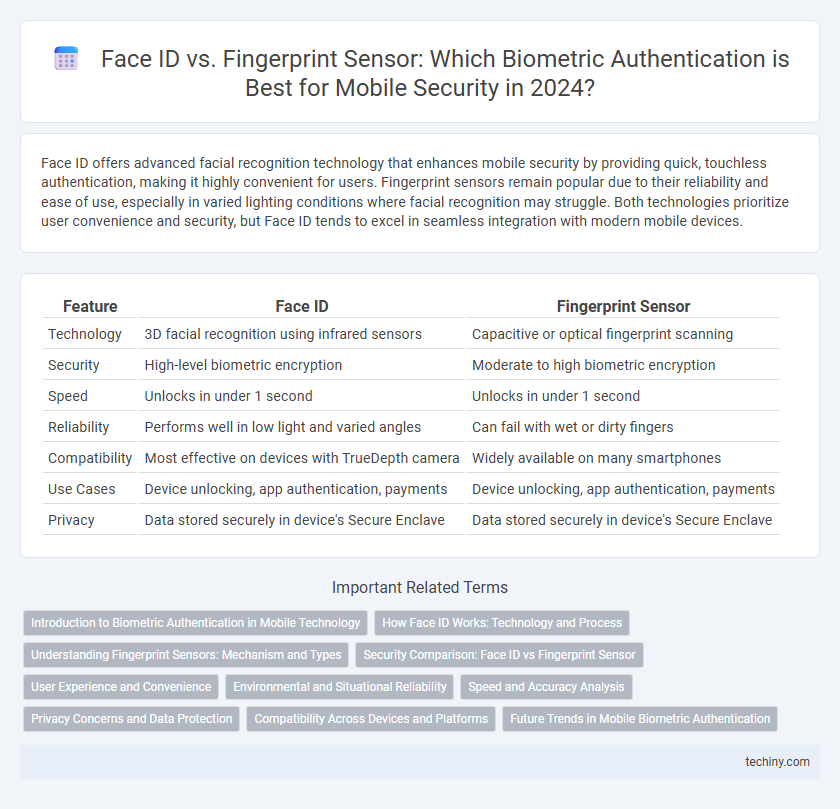Face ID offers advanced facial recognition technology that enhances mobile security by providing quick, touchless authentication, making it highly convenient for users. Fingerprint sensors remain popular due to their reliability and ease of use, especially in varied lighting conditions where facial recognition may struggle. Both technologies prioritize user convenience and security, but Face ID tends to excel in seamless integration with modern mobile devices.
Table of Comparison
| Feature | Face ID | Fingerprint Sensor |
|---|---|---|
| Technology | 3D facial recognition using infrared sensors | Capacitive or optical fingerprint scanning |
| Security | High-level biometric encryption | Moderate to high biometric encryption |
| Speed | Unlocks in under 1 second | Unlocks in under 1 second |
| Reliability | Performs well in low light and varied angles | Can fail with wet or dirty fingers |
| Compatibility | Most effective on devices with TrueDepth camera | Widely available on many smartphones |
| Use Cases | Device unlocking, app authentication, payments | Device unlocking, app authentication, payments |
| Privacy | Data stored securely in device's Secure Enclave | Data stored securely in device's Secure Enclave |
Introduction to Biometric Authentication in Mobile Technology
Biometric authentication in mobile technology leverages unique physiological traits such as fingerprints and facial features to enhance security and user convenience. Face ID uses advanced infrared sensors and 3D depth mapping to accurately recognize facial patterns, while fingerprint sensors rely on capacitive or ultrasonic technology to identify fingerprint ridges. Both methods provide secure, fast, and contactless access, with ongoing innovations driving improvements in accuracy and anti-spoofing capabilities.
How Face ID Works: Technology and Process
Face ID employs advanced infrared sensors and a dot projector to create a detailed 3D map of the user's face, enabling secure authentication even in low light conditions. This technology captures over 30,000 invisible dots to analyze facial features, then uses a neural network to match the data with the stored facial profile. The secure enclave processes this biometric data locally, ensuring privacy while providing fast and accurate unlocking on compatible devices.
Understanding Fingerprint Sensors: Mechanism and Types
Fingerprint sensors use capacitive, optical, or ultrasonic technology to capture unique ridge patterns of a finger for secure authentication. Capacitive sensors measure electrical signals, optical sensors create a digital image using light, and ultrasonic sensors use sound waves to map fingerprint details in 3D. Each type offers different levels of accuracy, speed, and resistance to spoofing in mobile device security.
Security Comparison: Face ID vs Fingerprint Sensor
Face ID uses advanced 3D facial mapping technology with infrared sensors, offering higher security protection against spoofing compared to traditional fingerprint sensors that rely on 2D fingerprint patterns. Apple reports Face ID has a one in 1,000,000 chance of false acceptance, while Touch ID has a one in 50,000 chance, highlighting Face ID's superior resistance to unauthorized access. Both systems employ secure enclaves for data encryption, but Face ID's dynamic facial recognition adapts to changes in a user's appearance, enhancing long-term authentication accuracy.
User Experience and Convenience
Face ID delivers a seamless, hands-free authentication experience that adapts well to various lighting conditions and angles, enhancing user convenience and speed. Fingerprint sensors provide a reliable and quick unlocking method, especially useful when facial recognition struggles with masks or sunglasses. Both technologies optimize mobile security, but Face ID excels in offering a more intuitive and futuristic user experience.
Environmental and Situational Reliability
Face ID offers higher environmental adaptability with strong performance in low light and wet conditions, while fingerprint sensors may struggle with moisture and dirt interference. Fingerprint technology faces challenges outdoors or with gloves, limiting reliability depending on situational factors. Advancements in biometric algorithms continue to improve face recognition robustness against varied environmental influences.
Speed and Accuracy Analysis
Face ID utilizes advanced infrared and depth-sensing technology to provide rapid and secure facial recognition, often unlocking devices in under a second with high accuracy even in low light. Fingerprint sensors rely on capacitive or optical scanning, offering consistent speed but sometimes affected by finger moisture or dirt, potentially lowering accuracy. Comparative studies indicate Face ID generally delivers faster authentication and superior accuracy, especially in varied environmental conditions, making it a preferred choice for seamless mobile security.
Privacy Concerns and Data Protection
Face ID uses advanced 3D facial mapping technology to securely store biometric data in the device's secure enclave, minimizing the risk of data breaches compared to traditional fingerprint sensors. Fingerprint sensors, while convenient, transmit and process fingerprint data that can potentially be intercepted or spoofed if not adequately protected by encryption and hardware security measures. Both systems implement strict privacy protocols, but Face ID's use of neural networks and anti-spoofing algorithms offers enhanced protection against unauthorized access and spoofing attacks.
Compatibility Across Devices and Platforms
Face ID offers seamless integration primarily within Apple's ecosystem, ensuring consistent performance across iPhone and iPad models that support the technology. Fingerprint sensors boast broader compatibility, functioning across various devices and platforms, including Android smartphones, laptops, and biometric readers. This widespread adoption makes fingerprint authentication more versatile for users operating multiple device brands or cross-platform environments.
Future Trends in Mobile Biometric Authentication
Face ID and fingerprint sensors represent key biometric authentication methods in mobile technology, with Face ID increasingly leveraging 3D facial recognition and infrared sensing for enhanced security. Future trends indicate a shift towards multimodal biometrics combining facial recognition, fingerprint scanning, and even voice or iris scans for higher accuracy and fraud prevention. Emerging technologies emphasize AI-driven pattern analysis and continuous authentication to ensure seamless, adaptive security in evolving mobile environments.
Face ID vs Fingerprint sensor Infographic

 techiny.com
techiny.com